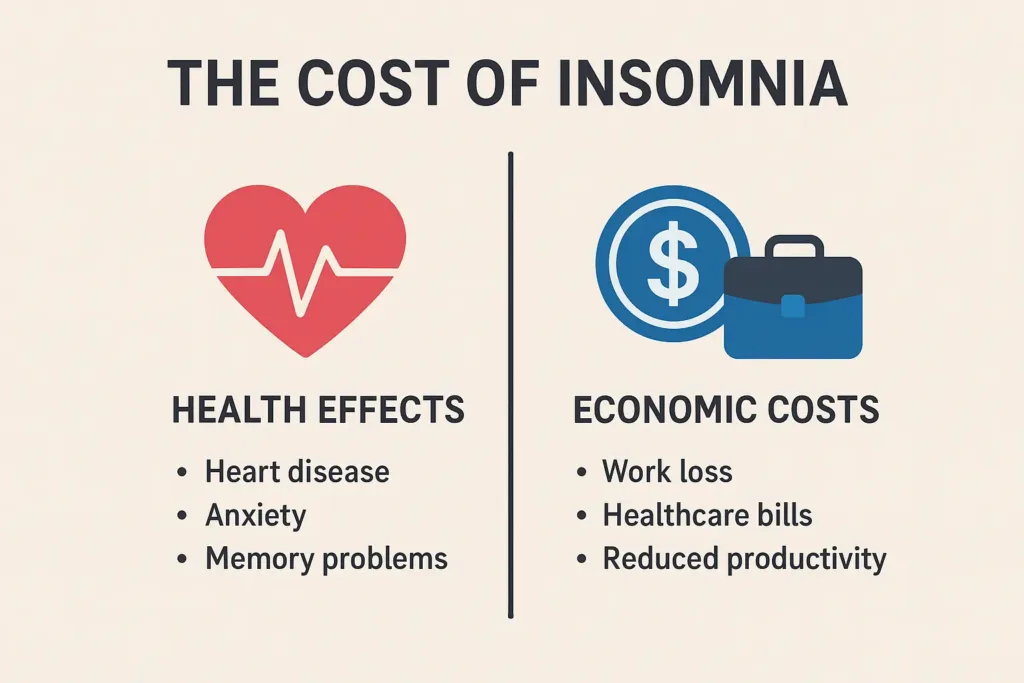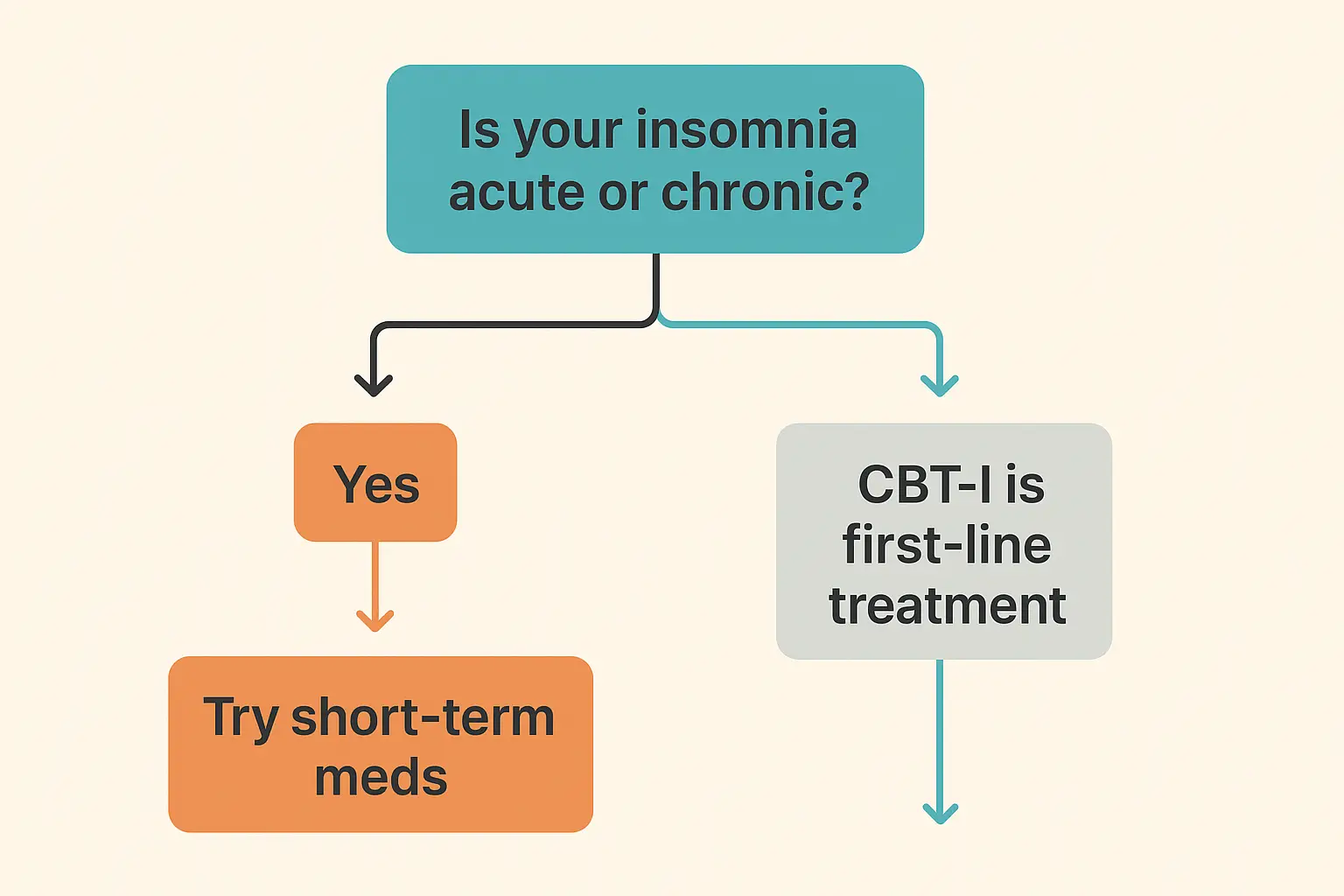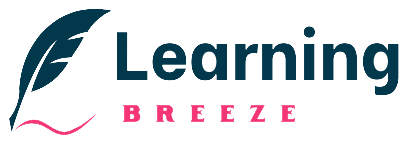Does it often happen to you that you lie down at night and stare at the ceiling, the time turning from minutes to hours, but you can’t sleep? You’re not alone in this. According to a report by the National Institutes of Health, roughly 30% to 35% of young adults worldwide experiencing at least one symptom of insomnia. This is really a problem because if you stay awake for hours throughout the night, you will not get enough sleep, and if you do not get enough sleep, you can become physically and mentally ill. Insomnia is a complex condition that increases your risk of heart disease, depression, diabetes, and even early death. And when you go for treatment for insomnia, you also need to make an important decision: should you choose CBT-I vs medications for insomnia?

It’s not a simple choice. On the one hand, you’re promised instant relief with sleeping pills. On the other, a slower, more fundamental change offered by CBT-I for insomnia vs medications. The debate is often explained as a quick fix versus a long-term solution, but what does the science actually say?
In this comprehensive guide, we will help you decide right here. After reading this article, you will understand which method is best when and we will tell you strategies that you can incorporate into your life starting today. So let’s consider what science says about overcoming insomnia.
What Is CBT-I?
CBT-I, or cognitive behavioral therapy for insomnia, is a structured, evidence-based program designed to help you identify the thoughts and behaviors that prevent you from sleeping well. Sleeping pills only provide temporary relief. In contrast, CBT-I targets the underlying cause of chronic insomnia. It’s not just a set of suggestions; it’s a multi-part therapy that retrains your mind and body for healthy sleep.
Basic Components of CBT-I
CBT-I usually combines several practical techniques:
1. Sleep Restriction Therapy
These techniques may seem, on the surface, to be diametrically opposite. This actually limits your time in bed to match your actual bedtime. If you only sleep for 5 hours but are spending 8 hours in bed, you will initially be limited to 5.5 hours in bed. As your sleep efficiency improves (the percentage of time in bed that is actually spent sleeping), your sleep window will gradually expand.
2. Stimulus Control Therapy
Stimulus control retrains your brain to use the bed for sleep instead of worrying and to think only about sleep instead of just here and there. The principles are simple but powerful: use the bed only for sleep and intimacy, leave the bedroom if you can’t fall asleep within 15-20 minutes, and maintain wake times regardless of how much sleep you get.
3. Cognitive Restructuring
This section addresses the racing thoughts and worries that keep you awake. You learn to challenge and reframe unhelpful beliefs about sleep with more balanced, realistic thoughts (e.g., “I’ll never sleep again,” “I need 8 hours to function”).
4. Relaxation Training
These techniques, such as progressive muscle relaxation or mindfulness, help calm the mind and body, making it easier to fall asleep.

If you’re looking for a structured guide, the book “Say Good Night to Insomnia” by Gregg D. Jacobs provides a step-by-step CBT-I program developed at Harvard Medical School.
What Do Sleeping Pills Do?
When people complain of lack of sleep, they quickly turn to medicine because they provide quick relief. Therefore, people buy medicine and use it. But it is important to understand how these medications work and how they can affect our bodies. Sleeping pills — or hypnotics — work by targeting brain chemicals that regulate sleep and wakefulness. They are often prescribed when patients need immediate relief, such as during stressful periods, while waiting for CBT-I to take effect, or in cases of severe sleep disruption.
But the drugs don’t address the cause of insomnia. Instead, they temporarily adjust brain activity to promote sleep onset and maintenance. Let’s break down the main classes of sleep medications.
1. Z-drugs (zolpidem, eszopiclone)
Z-drugs are the most commonly prescribed modern hypnotics. They act on the brain’s GABA receptors, increasing calming signals that make it easier to fall asleep and stay asleep. Zolpidem (Ambien) and eszopiclone (Lunesta) are popular choices.
- Benefits: Rapid onset, effective for reducing sleep latency.
- Risks: Next-day grogginess, memory issues, and in some cases, sleepwalking or unusual behaviors.
2. Benzodiazepines
An older class of sleep medications, benzodiazepines (such as temazepam) are also GABA enhancers. They are effective but carry a higher risk of dependence, tolerance, and withdrawal symptoms.
- Benefits: Strong sedative effect, can help with both falling asleep and staying asleep.
- Risks: Daytime drowsiness, cognitive impairment, fall risk (especially in older adults), and addiction potential.
3. Orexin Antagonists (suvorexant, lemborexant)
A newer generation of drugs, these block orexin, a neurochemical that keeps us awake. By reducing orexin activity, they help the body transition naturally into sleep without suppressing deep stages.
- Benefits: Lower risk of dependency than benzodiazepines.
- Risks: May still cause next-day drowsiness and, in rare cases, vivid dreams or sleep paralysis.
4. Melatonin Agonists (ramelteon)
Rather than sedating, melatonin agonists mimic the body’s natural sleep hormone. Ramelteon, for example, is often prescribed to regulate circadian rhythm disorders like delayed sleep phase syndrome.
- Benefits: Non-addictive, safe for long-term use.
- Risks: Less potent than other hypnotics; works best for sleep onset problems rather than maintenance.
How Sleep Medications Help
The primary benefits of sleeping pills are immediate and measurable. Clinical trials consistently show that most sleeping pills can reduce sleep latency by 10 to 40 minutes and increase total sleep time by 30 to 90 minutes within the first few nights of use. For someone who is experiencing severe insomnia—perhaps due to jet lag, stress, or a major life change—this rapid relief can prevent the development of chronic sleep problems.
Sleep medications also provide psychological comfort. Knowing that you have a “safety net” can reduce anxiety about sleep, potentially breaking the cycle of worry that perpetuates insomnia. This confidence boost should not be underestimated, as sleep anxiety is a key factor in chronic insomnia.
Risks and Limitations
While medications can provide rapid relief, their drawbacks are significant:
- Dependence & Tolerance: The body adapts over time, meaning higher doses may be needed to achieve the same effect.
- Cognitive & Physical Impairment: Next-day drowsiness, reduced reaction times, and memory problems are common.
- Withdrawal & Rebound Insomnia: Stopping abruptly can make sleep problems worse.
- Health Risks for Older Adults: Higher chance of falls, fractures, and confusion.
For readers who want to explore the science of sleep medications and safer strategies, Matthew Walker’s “Why We Sleep” provides a research-backed, engaging explanation of how drugs affect the architecture of sleep.
CBT vs Medications: Head-to-Head Evidence
Now that we’ve studied how CBT-I and sleeping pills work, the real question remains: which option actually delivers better sleep outcomes?
When we look at the scientific evidence from randomized controlled trials (RCTs), a clear picture emerges about the effectiveness of both treatments. The difference is not just in how they work, but also in the speed of their effect and their long-term outcomes.
Comparison of Treatment Effectiveness
The following table summarizes the main findings from major comparative studies.
| Outcome Measure | CBT-I | Sleep Medications | Winner |
|---|---|---|---|
| Onset of Effect | 2–4 weeks | 1–3 nights | Medications (short-term) |
| Sleep Latency Reduction | 15–25 minutes | 10–30 minutes | Similar effectiveness |
| Total Sleep Time Increase | 20–45 minutes | 30–60 minutes | Medications (slight edge) |
| Sleep Efficiency Improvement | 10-15% increase | 5-10% increase | CBT-I |
| Durability After Stopping | Benefits maintained 2+ years | Immediate return of symptoms | CBT-I (clear winner) |
| Side Effects/Safety | Temporary sleep restriction fatigue | Multiple risks (dependence, falls, cognitive impairment) | CBT-I (clear winner) |
Research has repeatedly shown that while sleeping pills work faster, CBT-I provides more lasting results. For example, one landmark study found that while both CBT-I and popular Z-drugs like zopiclone were effective in the short term, only CBT-I maintained its positive effects for more than a year after treatment ended. This highlights why major medical organizations, such as the American College of Physicians, recommend CBT-I as a first-line treatment for chronic insomnia.
The rise of digital CBT-I (dCBT-I) has made this therapy more accessible. Apps and online programs deliver the core components of CBT-I in a convenient, structured format. A study published in JAMA Psychiatry found that digital CBT-I is just as effective as traditional face-to-face therapy, making it a powerful tool for people who can’t access a therapist.
Which Works Best for Different Situations?
Finding the right treatment for insomnia often depends on the underlying cause, severity, and the individual’s lifestyle. Neither cognitive behavioral therapy nor medication for insomnia (CBT-I) is a one-size-fits-all solution—instead, each works best in specific situations.
1. Acute Insomnia (Less Than 3 Months)
If your insomnia is short-term and caused by stress, such as losing a job, a change in a relationship, or a medical procedure, a short course of sleep medication may help prevent it from becoming a long-term problem. The goal is to prevent poor sleep habits from becoming permanent.
For example, if you are going through a divorce and have not slept well for two weeks, feel anxious about sleep and avoid your bedroom, taking a sleep aid for 1-2 weeks along with good sleep habits can help you return to normal sleep before it becomes chronic.
2. Chronic Insomnia (3 Months or Longer)
For long-term insomnia, CBT-I is a good first choice. By this time, your sleep problems are rooted in habits and thoughts, no matter how they started. Medication alone usually doesn’t solve the problem long-term and can even slow your recovery by preventing you from learning natural ways to sleep better. The American Academy of Sleep Medicine recommends CBT-I first for adults with chronic insomnia because it works better over time and is safer.

CBT-I vs Medications for Insomnia in Special Cases
1. Older Adults
Older adults often have more problems with both treatments. Aging naturally reduces sleep, and many older people take various medicines that can interfere with sleep medications. CBT-I is usually safer and works better here as it does not increase the risks such as falling or memory issues. Nevertheless, some parts of CBT-I may need to be adjusted to avoid too much fatigue a day.
2. Comorbid Conditions
People with depression or anxiety often have chronic insomnia (70-80%). CBT-I can improve both sleep and mood at the same time. Treating insomnia with CBT-I often helps without direct treatment for depression. However, medicines do not decide how sleep and moods affect each other.
3. Shift Workers
Shift workers present a unique challenge, as their insomnia is often the wrong setting of circadian rhythm. The strategic use of melatonin or melatonin agonists, combined with modified CBT-I techniques and light therapy, often provides excellent results. Traditional sleep medicines are less effective because they do not remove basic circadian obstruction.
Strategic Tapering Approach
A step-by-step plan is needed to successfully transition from medication to CBT-I. A tried-and-tested method used in sleep clinics is:
Weeks 1-2: Start CBT-I while maintaining your current medication dosage. Focus on good sleep habits and controlling your sleep environment. Start keeping a detailed sleep diary to track your patterns.
Weeks 3-4: Start limiting your time in bed and gradually taper your medication. Reduce the dose by 25% every 1-2 weeks while closely monitoring your sleep quality.
Weeks 5-8: Continue to taper medications using more CBT-I techniques. Include exercises to help change negative thoughts about stopping medications.
Weeks 9-12: Stop the medication completely but continue all of the CBT-I methods. You may experience some temporary sleep problems as your brain re-adapts to natural sleep patterns.
Practical CBT-I Starter Kit
Starting CBT-I may find it difficult, but you can start with some easy, practical steps. Continuous effort is the solution to every problem.
1. Start a Sleep Diary
For at least one to two weeks, write a detailed diary of sleep. Record when you sleep, how long do you wake up, how long do you think you are asleep, but no awareness. This data is essential to understanding your sleep pattern and implementing strategies such as sleep restriction therapy.
2. Sleep Restriction Example (Step-by-Step)
- Use your sleep diary to calculate your average total sleep time. Let’s say it’s 5.5 hours.
- Limit your time in bed to that same amount, plus 30 minutes. So, you might go to bed at 12:00 AM and set your alarm for 6:00 AM, spending only 6 hours in bed.
- Over the coming weeks, as your sleep efficiency improves (aiming for over 85%), you can gradually increase your time in bed by 15-30 minutes, until you reach a healthy amount of total sleep.
3. Stimulus Control Guidelines
Transform your bedroom into a sleep sanctuary with these evidence-based rules:
Do’s:
- Use the bed only for sleep and intimacy
- Maintain the same wake time daily, including weekends
- Get out of bed if you can’t fall asleep within 15-20 minutes
- Return to bed only when genuinely sleepy
- Create a relaxing pre-sleep routine starting 30-60 minutes before bed
Don’ts:
- Never use electronic devices in bed (phones, tablets, TV)
- Don’t eat, work, or have intense conversations in the bedroom
- Avoid watching the clock during nighttime awakenings
- Don’t stay in bed hoping sleep will come—this teaches your brain that beds are for lying awake
- Never nap to “catch up” on lost sleep
4. What Weeks 1-4 Usually Feel Like
This initial phase of sleep restriction can be difficult. You may feel sleepy and tired in the day. This is a normal and expected part of the process, as you are making a powerful sleep drive. Fatigue is a sign that therapy is working. Up to 3 or 4 week, most people begin to delay their sleep and improve quality.
Global Treatment Costs Comparison of CBT-I vs Medications for Insomnia
The availability and cost of treatment varies depending on your location, whether it is CBT or medication. The cost can be determined based on your location. Globally, traditional in-person therapy can be expensive, with the average cost ranging from $100 to $250 per session. However, the rise of digital therapy and telehealth has made CBT-I far more accessible. Many dCBT-I apps and programs offer a structured course for a fraction of the cost, often involving a one-time fee or monthly subscription.
In regions like South Asia (Pakistan/India), in-person therapy may be less common or harder to find, but telehealth and digital solutions are gaining ground. There are a growing number of local mental health platforms and apps that offer specialized programs. From an affordability perspective, many health insurance plans now to cover CBT-I, recognizing it as a proven medical treatment for insomnia. It’s always a good idea to check with your insurance provider.
The Verdict — Which Should You Choose?
When it comes to treating insomnia, the science is clear. For a long-term solution that addresses the root of your sleep problems, CBT-I is the best option. It gives you the skills to manage your sleep for the rest of your life without the risks of addiction or side effects from long-term medication.
However, medications can still be helpful. For short-term insomnia or when you need a quick fix, sleeping pills can provide temporary relief. The bottom line is that the best choice depends on your situation — it’s not the same for everyone.
Remember, both options can help. Improving your sleep is a team effort between you and your doctor. Talk to your doctor about your options and look into CBT-I tools, whether with a therapist or through a digital program. Taking the first step is the most important part of getting better rest.
Recommended Reads for Curious Minds
- A Natural History of the Senses by Diane Ackerman
- The Sleep Solution: Why Your Sleep is Broken and How to Fix It by Dr. Chris Winter M. D.
- Sleep Medicine: A Comprehensive Guide to Its Development, Clinical Milestones, and Advances by Sudhansu Chokroverthy
- The Insomnia Workbook: A Guided CBT-I Program by Stephanie Silberman
FAQ Section
Most people begin seeing improvements in sleep quality within 2-4 weeks of starting CBT-I, with significant benefits typically achieved by 6-8 weeks. However, the initial weeks often involve temporary sleep restriction that can increase daytime fatigue before improvement occurs. Unlike medications that work immediately, CBT-I builds cumulative benefits that strengthen over time and persist long after treatment completion.
Generally, no. The American Academy of Sleep Medicine and other major medical bodies do not recommend the long-term use of most sleeping pills due to the risks of tolerance, dependence, and side effects like next-day drowsiness and falls.
Yes, but this should only be done under the supervision of a doctor. The goal is often to use medication for short-term relief while you learn and implement the long-term skills taught in CBT-I, with a plan to gradually taper off the medication.
Yes, many studies have shown that digital CBT-I (dCBT-I) programs and apps are as effective as traditional face-to-face therapy. They are an accessible and affordable option for many people.




